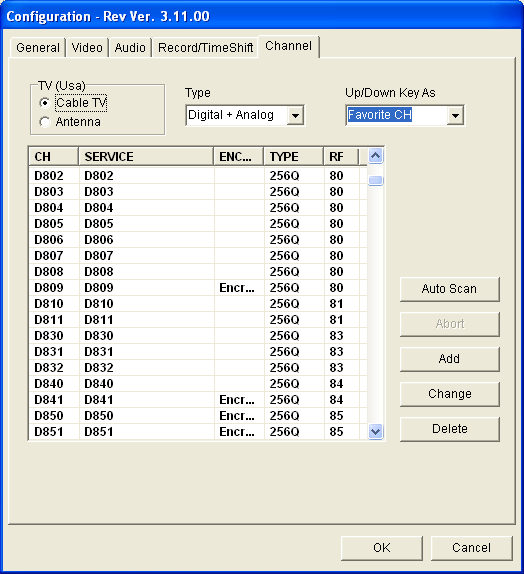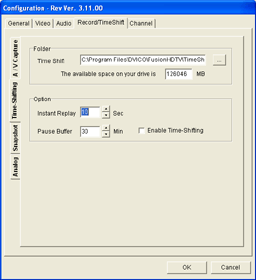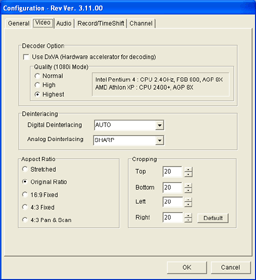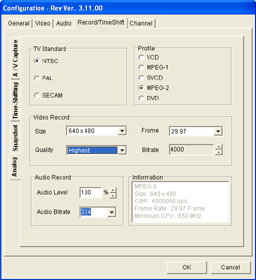HTPC - TV Tuner Reviews
by Jarred Walton on December 7, 2005 12:05 AM EST- Posted in
- Smartphones
- Mobile
DVICO Fusion5 Gold (cont'd)
The Fusion5 card can function in multiple ways, and how you plan to use the card will affect the configuration process. FusionHDTV supports standard analog TV reception, OTA DTV reception, and the ability to decode digital cable content (provided that it isn't encrypted). These last two features are also referred to as the ability to decode 64/256 bit QAM content (for digital cable) and 8VSB content (for OTA DTV).
When you first launch FusionHDTV, it will ask if you want to scan for channels. Say "no" and then specify the type of connection that you're using first: cable or antenna, and then select analog, digital or both for the channel type. At this point, you can click the "Start Scan" button and wait a few minutes. (It took about 4.5 minutes to scan through the digital channels and another 1.5 minutes for the analog channels.)
Most of the configuration options are pretty much self-explanatory. You can see several of the screens above. Timeshifting is grayed out on analog channels but is available for digital channels. Depending on which station you're currently tuned in to, you may or may not be able to check the timeshifting box.
The video options allow you to specify how the content should be shown. "Original Ratio" is our preferred choice, as any form of stretching tends to look bad. Some people don't like having black areas on widescreen displays, though, so the ability to switch to a stretch or zoom mode will keep them happy. The remote actually has a button that toggles between these three modes, which can come in handy.
Digital and analog recording have separate options, although the computer speed may play a role in what you select. You can capture digital streams as either the raw transport stream (with a .TP extension) or as a "Native MPEG" stream. "Native MPEG" mode converts the transport stream to a program stream (.MPEG extension), which usually has very little impact on performance or file size (and no impact on quality). However, it can save a lot of space if you're capturing an SDTV show where there are lots of extra bytes for other subchannels or null packets in the TS that are stripped from the PS. Given this information, Native MPEG seems to be the better choice, though in our sample videos (which were of HDTV), we chose to capture the raw TS.
Analog capture only allows MPEG2 encoding, but with several quality presets available. Choosing 640x480 and Highest Quality result in a data rate of 4000 Kbits/s and little to no loss in quality, so that's what we chose. That will use around 30 MB per minute of video - that's one-fourth to one-fifth the amount of disk space as a typical 720p/1080i HD transport stream, in case you were wondering. With hard drives costing around 40 cents per GB for the best deals, we recommend grabbing a 250GB drive (or several) and using higher quality capture options rather than worrying about disk space.
The Fusion5 card can function in multiple ways, and how you plan to use the card will affect the configuration process. FusionHDTV supports standard analog TV reception, OTA DTV reception, and the ability to decode digital cable content (provided that it isn't encrypted). These last two features are also referred to as the ability to decode 64/256 bit QAM content (for digital cable) and 8VSB content (for OTA DTV).

When you first launch FusionHDTV, it will ask if you want to scan for channels. Say "no" and then specify the type of connection that you're using first: cable or antenna, and then select analog, digital or both for the channel type. At this point, you can click the "Start Scan" button and wait a few minutes. (It took about 4.5 minutes to scan through the digital channels and another 1.5 minutes for the analog channels.)
 |
 |
| Click to enlarge. | |
Most of the configuration options are pretty much self-explanatory. You can see several of the screens above. Timeshifting is grayed out on analog channels but is available for digital channels. Depending on which station you're currently tuned in to, you may or may not be able to check the timeshifting box.
The video options allow you to specify how the content should be shown. "Original Ratio" is our preferred choice, as any form of stretching tends to look bad. Some people don't like having black areas on widescreen displays, though, so the ability to switch to a stretch or zoom mode will keep them happy. The remote actually has a button that toggles between these three modes, which can come in handy.
 |
 |
| Click to enlarge. | |
Digital and analog recording have separate options, although the computer speed may play a role in what you select. You can capture digital streams as either the raw transport stream (with a .TP extension) or as a "Native MPEG" stream. "Native MPEG" mode converts the transport stream to a program stream (.MPEG extension), which usually has very little impact on performance or file size (and no impact on quality). However, it can save a lot of space if you're capturing an SDTV show where there are lots of extra bytes for other subchannels or null packets in the TS that are stripped from the PS. Given this information, Native MPEG seems to be the better choice, though in our sample videos (which were of HDTV), we chose to capture the raw TS.
Analog capture only allows MPEG2 encoding, but with several quality presets available. Choosing 640x480 and Highest Quality result in a data rate of 4000 Kbits/s and little to no loss in quality, so that's what we chose. That will use around 30 MB per minute of video - that's one-fourth to one-fifth the amount of disk space as a typical 720p/1080i HD transport stream, in case you were wondering. With hard drives costing around 40 cents per GB for the best deals, we recommend grabbing a 250GB drive (or several) and using higher quality capture options rather than worrying about disk space.










77 Comments
View All Comments
Brian23 - Thursday, December 8, 2005 - link
I'm supprised more people aren't talking about this. I haven't downloaded them, but I assume they are recordings of OTA broadcasts. If that's the case, then I'm suprised Anandtech posted them. In the news section they're always posting stuff about how people are getting sued for sharing movies. Most of the movies out there on torrents have been broadcast OTA at some point which would make them public domain. Everyone is so quick to judge someone when they post a torrent of something, but mysteriously no-one has said anything about this yet.JarredWalton - Thursday, December 8, 2005 - link
They're basically 30 second clips demonstrating analog/HDTV videos. If anyone wants to come after me for posting sample content... wow, they have way too much time on their hands. I guess I didn't bother to get "express, written consent" though....Brian23 - Thursday, December 8, 2005 - link
I don't fault you for posting this, and I don't think you need express written consent. I think the whole lawsuit thing over p2p file sharing is a bunch of crap. My point I was trying to make in my previous post was that I was suprised that no-one was was posting anything about copywrite violations. Normally the people here at Anandtech scream and yell if there's something being distributed that's copywritten, no matter what it is. I think people should be able to share stuff that they recorded from OTA.valnar - Wednesday, December 7, 2005 - link
Perhaps I missed something in the review, but what's the point of posting screen shot comparisons of a transport stream? They would all be identical across all the cards, unless there were bit errors in the stream. Of course they all look good! They should also look the same too. The only way to show a difference would be through a video card, such as a particular ATI or nVidia in either overlay or VMR9 mode. Or with the hardware output of the MyHD series of cards, which is vastly superior to the software based cards. If you have an HDTV and have used the DVI or Component out of the MDP-1xx, they are fantastic. Of course, a screenshot wouldn't show that. Maybe a digital photo or something(?).It should also be noted that watching HDTV on overlay is a big no-no. The overlay was never meant to register more than 540 lines of resolution. While deciding between overlay or VMR9 for DVD (740x480/NTSC) watching is a matter of religious debate, overlay can never resolve HD properly. I would submit that the reviewer possibly didn't see any of those cards in their full glory.
-Robert
xtknight - Wednesday, December 7, 2005 - link
Where is this overlay limitation stated and what happens when you go above said lines? I'm sorry but I find that hard to believe. SIL overlay vs. SIL VMR9 looks the exact same to me as I remember it. What does 540 lines mean? What resolution is the max (x by y)?JarredWalton - Wednesday, December 7, 2005 - link
I'm a little confused by this overlay limitation as well. I mean, obviously the Fusion5 only works through overlay, but the video stream is transferred digitally from the TV Tuner to the graphics card. There should be no limitation other than bandwidth, I thought? Maybe I'm using the term "overlay" incorrectly here?As for the HD images, I mentioned that they are all identical for TP captures. They were included to show people exactly how much data HDTV contains (and how much better looking HDTV is) relative to analog/SDTV. The upsampled SDTV image is also there to show how poor that looks in comparison to a real HDTV stream - and I get far too much upsampled content on most HD channels.
valnar - Thursday, December 8, 2005 - link
These limits are discussed in all the usual forums, like avsforum.com.JarredWalton - Thursday, December 8, 2005 - link
Link please? I just don't see how the hardware overlay interface on your video card could possibly be limited to only 720 x 480. Windows Media Player uses the overlay mode for playing video. Last I checked, it's fully capable of playing 1080I resolution. NTSC signals have nothing to do with overlay mode inside computers.valnar - Thursday, December 8, 2005 - link
It not limited per se, but you won't see much of an improvement at a rez above 540 lines horizontal. Everything (like WMP) can use the Overlay, but if you were to truly show a video in 1080P mode, for example, it wouldn't be as sharp - because of most video card overlay limitations. It's hard to explain, as the resolution of overlay is more an "analog" style of limitation, to use that metaphor inaccurately. It simply doesn't resolve the detail of HDTV, period. Get a 100" screen and a projector and it becomes obvious. Forgive me for not being able to articulate it, hence my recommendation to visit Home Theater/HTPC specific forums.xtknight - Thursday, December 8, 2005 - link
I can't find anything about this limitation with google or avsforum search. Are you mixing up overlay with interlacing? It would be nice if you could provide us with a link because we effectively have no clue what you're talking about here...